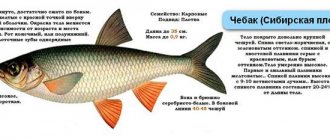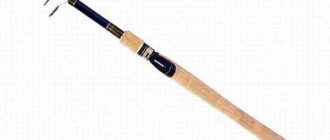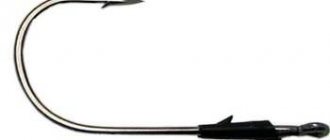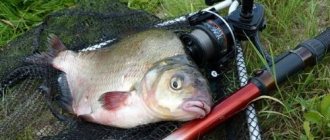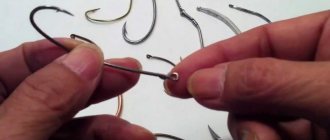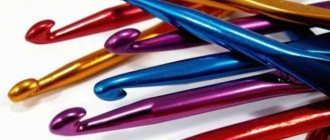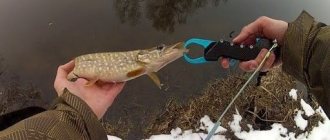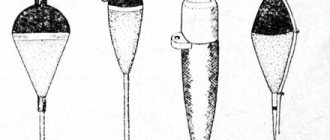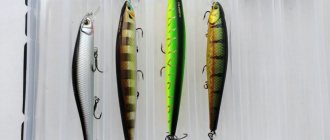Types of hooks for catching pike
Catching pike is a labor-intensive process, but under the right conditions it can show the best results. In this case, not only the current and depth of the water are important, but also the quality of the gear, including the hook. You need to pay attention to the size, design, shape and other parameters of the hook, which will undoubtedly affect the amount of catch. There are several types of pike hooks:
- Offset.
- Double hook or double.
- Tee.
The shape and size of the hook directly depend on the size of the expected catch, the method of baiting the bait and other parameters. For example, a large hook will not allow the pike to capture it completely. A hook that is too small will not be able to grip the fish's mouth sufficiently.
The most optimal hook size for catching pike is considered to be a hook number 3-7.
Sometimes fishermen construct special gear consisting of 2 or 3 hooks. It is important that before hunting the hook is so sharp that it can easily penetrate the body of the fish even with the slightest attack. Let's take a closer look at the features of each type of hook.
Photo: Pike on a hook
Offset (single)
This hook is a specially designed option that is designed to replace a conventional single hook for hunting predatory fish. It has a special shape - it has a special bend on the fore-end (the part of the hook from the head to the beginning of the hook) and is usually used when fishing with a spinning rod.
Offset hook
Offset hooks can be used for such types of installation as:
- Texas rig – suitable for fishing in thickets and snags.
- A retractable leader that performs best when catching calmer fish.
- Carolina rig is most suitable for live bait play.
- The drop shot is most often used for catching passive pike from a high bank, vertically or casting from a boat.
Double (double hook)
This type of hook is often used by fishermen in winter to install girders. The double is very convenient to remove from the depths of the pike’s mouth with minimal damage. It is also easy to attach live bait to catch small fish. The bait must be chosen of the appropriate size, since a small hook and a large nozzle will not give the expected result, although they will not cling to snags. Conversely, a large double and a small bait will cause constant snags in thickets and snags.
Live bait can be attached to such a hook in several ways. The most popular baits are under the gills, behind the back and behind the lip of live bait. Compared to a single hook, a double hook provides a greater chance of getting a bite, which is why it is popular with most fishermen.
Tee
Treble hooks are most often used in mid-water or sandy ponds where they are rarely likely to snag on anything. They can be used both in summer and winter. They can also be used for fishing with spoons, wobblers or balancers. One of the significant disadvantages of tees is their bulkiness, which increases the likelihood of them getting caught on snags. In addition, when fishing for pike, it sticks deep into its mouth, so it is difficult to remove it without special equipment.
About
Fishing Hook Size Charts
Today, two main hook numbering systems have become firmly established among fishermen:
- Soviet (domestic)
- international (western).
It's easy for an inexperienced beginner to get confused. And while studying the store catalog, you buy absolutely the wrong hooks that are needed. However, Russian and international numberings do not exhaust the entire topic. Although for us they are closer and more convenient than all the others.
There are also Finnish and Japanese numbering. See the table with sizes and corresponding numbers for each classification below.
Types and shapes of fishing hooks
In addition, fishing hooks also differ in shape and purpose. It is clear that for catching bleak, single high-quality hooks are sufficient. In general, today the range of hooks in fishing stores is huge. Their terminology is also varied.
Single Fishing Hooks
It is important not only to choose the right fishing hook, but also to tie it to the fishing line. Here is an example of using hooks of various shapes. And also the influence of proper knitting on the comfort and success of fishing.
Here are the types of the most popular hooks among fishermen.
These are all single hooks. There are also doubles (twins) and triples (trebles). They are used primarily for catching river predators: pike, asp, pike perch, perch, etc.
Twin Size Chart
Tees numbers and sizes
Non-snacking hooks for pike and their features
Underwater vegetation and snags often become an obstacle to a good catch, although it is in the dense thickets that the most fish are found. Pike is one of those fish that love algae and are found in places where vegetation, snags and stones accumulate. In such cases, when it is impossible to reach fish with ordinary baits, fishermen come to the aid of special non-snagging hooks, which show excellent results in snags. Most often, non-hooking rods are used when fishing for pike with a spinning rod.
Non-hooking boats may differ in their shape and design, but they all help to develop hard-to-reach and promising areas of reservoirs. The main types of non-hooking baits are jig baits, spinnerbaits, non-hooking spoons, gliders and others:
- Non-hooking lures have protection in the form of wire with special springs, fishing lines, some can even be hidden inside the baits. The principle of operation of such hooks is to bend the wires on a spring at the moment the pike grabs, as a result of which the fish can be detected. Minnow brand spinners are considered the most popular among unhooked ones.
- For lovers of jig fishing, offset hooks with silicone coating are offered, that is, the hook is hidden inside the silicone, which passes through the thickets without hindrance. There are also foam rubber baits with a double, the grip of which compresses the foam rubber, and the pike becomes prey.
- Gliders are most often used as bait for surface fishing. They have a voluminous shape and light weight, which is achieved due to the plastic used in manufacturing. Inside it there is a hook and a weight, and the non-hook itself easily slides along the surface, creating vibrations on the water. In its appearance and shape, the bait imitates small rodents or frogs.
- Spinnerbaits are considered one of the popular lures for spinning, although they are not so versatile for hunting in dense thickets and are successful mainly in snags.
Tips from experienced anglers
A subtle point that requires experience will be for a novice fisherman to determine the right moment to hook. There are several scenarios here, depending on the state of the reservoir, current, depth and bottom topography. Still, there are general techniques that are useful to remember.
Catching pike with a float rod using live bait from the shore, unlike spinning, does not require immediate hooking as soon as the float shows a bite. After all, a pike that has grabbed its prey will not greedily swallow the victim right here, but will try to drag it into its shelter, there it will turn its head inward and begin to feast on it. Therefore, the ideal option is to give her time and act for sure. Usually a pause of a quarter to half a minute is enough.
But if it is known for sure that the bottom is heavily snagged, the delay will end with the predator dragging the line into the thickets and getting it tangled. Here they either reduce the pause from the first bite to 10-15 seconds, or hold the reel without releasing the bait into a dangerous place (having taken the bait in its mouth, the pike will not throw it without reason).
Such subtleties are usually developed only by practice, so learning to catch pike with live bait from the shore using a float rod will have to be done by trial and error.
Finnish hook for pike
This type of hook has been known to anglers for a long time and is one of the most effective methods of successful fishing. It is made of steel spring wire 1 mm thick. It is easy to make, so many fishermen make it themselves.
A peculiarity of its design is that its fore-end is usually short and does not reach the gills of the fish, and there are 2 sharp barbels on it. Thanks to this structure, it easily falls into the throat and then into the stomach of the predator, after which the hook antennae stick into the tissue and become spaced, and sometimes the hook even comes out along with the entrails.
The predator almost never leaves such a bait, unless at the first stage of an attack or grip. Anglers are often advised to take spare leashes with Finnish hooks when hunting. This is necessary in cases where a predator takes the hook in its throat, and it remains in its stomach for an indefinite time. In this case, to continue hunting, it is more convenient to unfasten the leash and put on a new one.
Live bait is attached to such a hook in a special way. To do this, a method is used to pass a metal hook leader under the gills of the bait. Then it is taken out from under the gill cover and attached to the clasp on the fishing line of the girdle. With this method, the bait swims in a natural position and attracts the attention of a predator.
What kind of hook is needed to catch pike?
There are many opinions about which type of hook is most suitable for catching pike. Some use single hooks, some use treble hooks, but many agree that you need to choose a hook depending on the type of baitfish and the method of baiting it. In addition, hooks for pike fishing are selected depending on the type, length and height of the bait. When buying artificial fish, it is best to place them on the hook in order to understand how well it will sit on it.
Experienced fishermen also advise paying attention to such parameters as the quality of the wire, the width of the hook, the hook antennae bent inwards and the method of attaching the hook to the leader.
What size hook to choose for pike
As noted above, you first need to decide on the bait, and then select a hook in size for it. If you don’t get the ratio right, you can get fewer hooks on the bottom, but the number of slips and empty bites will also increase. It is important to remember that according to the international classification, as the number increases, the size of the hook becomes smaller. So, the smallest hook is considered to be No. 24.
Offset
For pike fishing, an offset hook of size No. 5/0 is most often used, but the bait must also match it. It is better to choose a hook whose length will be approximately 1/2 the length of the body of the bait.
Double
A double hook of size No. 7 according to domestic numbering will be most suitable for catching pike. According to the international classification, double No. 6-8 is often used.
Tee
When catching pike with live bait, tee No. 3-7 according to international numbering is mainly used. When spinning fishing, treble hooks are also often used.
Installation of gear for catching pike with live bait
Catching pike with live bait on a float, unlike other well-known methods of catching a predator (dozens of them have been invented: with a girder, donka, circle, set-up and others), does not require any special techniques for assembling gear.
Guide rings and a reel are attached to a solid or telescopic fishing rod, the fishing line is passed to the selected length and equipped with a float on a swivel and a sinker. The only peculiarity: you need a metal leash in front of the hook, otherwise the toothy fish will easily bite the fishing line.
Which hooks are better
To catch pike, different types of hooks and different techniques for installing them are used. They are selected depending on the time of year, the depth of the reservoir, the gear used and the fishing method. The most important requirement for a hook is its sharpness, since the pike’s mouth is hard and quite toothy, and it can be difficult to hook it securely.
For spinning fishing
The most popular baits for spinning fishing: wobblers, spoons and silicone baits. For each bait, appropriate hooks are selected.
- For oscillating and rotating spinners, single, double and triple hooks are used. Sometimes a hook with 4 or even more hooks is used.
- Wobblers are rarely equipped with double hooks; triple or single hooks are often used.
- Silicone baits are equipped with an offset, double or triple hook.
For fishing with silicone, it is better to purchase special offset hooks. They can be of various shapes. When choosing, you also need to focus on the size, shape of the bait and the expected weight of the trophy. If the bait is narrow-bodied and elongated, hooks with a straight shank are suitable. However, the most popular models are those with a wide curve on the fore-end - it is this shape that allows you to reliably hook the fish, thereby reducing the number of empty bites.
For zherlitsy
For girder fishing, all types of hooks are used, both single and double and tees:
- Single ones are used when the size of live bait is no more than 5 cm, but this method increases the number of times the predator leaves the hook.
- Double hooks are used for “lazy” rigging, when its forends are threaded through the gills of the baitfish, and the predator swallows it without noticing the hook. Therefore, the number of empty bites or abandoned live baits is much less.
Tees are often used for vents. They guarantee the maximum percentage of successful hooking and bringing the prey onto the ice.
Techniques for catching pike with live bait
There are no special seasonal techniques for float fishing for pike from a boat or shore, depending on the time of year. But keep in mind that in different seasons, live bait is able to manifest itself differently, maintaining equal attractiveness as prey.
The balance in the behavior of the pike itself also changes: caution combined with aggressiveness.
Spring
The spring feeding period after a hungry winter is an ideal time for prey. The pike grabs everything that comes into its field of vision. However, fishing during spawning is considered not only illegal, but also unsporting. Moreover, the fish after it is greatly weakened, and its value for culinary needs is low.
Summer
Summer pike usually stands in reed thickets, from where it comes out to hunt at its own hours (usually in the early morning and late evening dawn). If you catch a predator on the edge between overgrown shallow water and deep water at a time when schools of small fish appear there, you will be able to waylay a worthy specimen.
Autumn
With the approach of the cold season, pike begin to fill up their winter reserves, which is why the measured summer bite on schedule noticeably intensifies.
Fishing for pike with live bait
At this time of year, the most noticeable thing in the water is the elegant rudd, which should be given preference when choosing live bait.
How to remove a pike from a hook
In addition to good equipment and a suitable hook, you need to have a special tool in your arsenal to remove the hook from the fish’s mouth. Zevnik - extractor for pike (fishing clamp or tongs). Of course, the small teeth of a pike will not allow you to bite off a fisherman’s hand or drag a dog near the water, but some precautions still need to be taken.
Using a yawner to remove the hook
Yawner and extractor
Photo: Fishing clamp
How to remove a hook from a pike
Correctly remove the hook from a caught pike as follows:
- Having pulled the pike out of the water, you need to lay it with its head to the left; if the angler is right-handed, the glove should also be put on your left hand.
- Next, you should pass 2 fingers along the gill wall into the gap under the jaws and lift the pike’s head so that the mouth opens.
- When hooking correctly, the nozzle should be near the mouth. You can remove it using a fishing clamp. If this is a tee, then you can ask your partner for help to hold the leash.
- Some anglers still use a pike yoke, which helps keep the mouth open to remove the hook.
- If the fish has deeply swallowed the hook, then you can use a special industrial hook remover or extractor.
The use of a barbless hook and proper hooking are a guarantee of unimpeded removal from the predator’s mouth.
For successful pike hunting, it is important to choose the right type of hook. Pay attention to the material it is made of, the bait used and its size. In addition, the type of reservoir, current, time of year and, of course, the weight of the fish itself are of great importance. In order to get a good catch, you should stock up on different types of hooks. And use them, adapting to specific fishing conditions.
Views: 3,006
